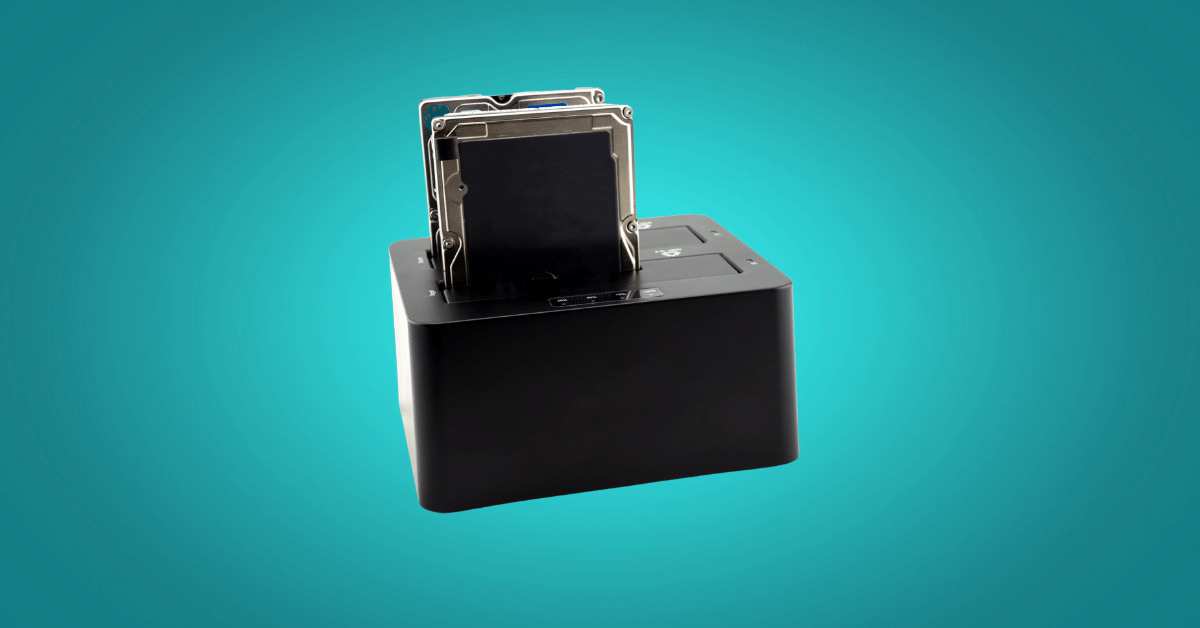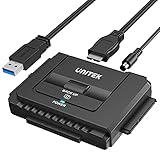Are you overwhelmed by the number of hard drive docking stations available out there? Don’t worry, we’ve got your back! In this blog post, we’ll explore the best hard drive docking stations on the market and help you make an informed decision. So if you’re looking for a reliable companion to store your data, join us on this exciting journey as we uncover the best dock for you.
A hard drive docking station is a handy peripheral device that enables quick and easy access to multiple hard drives for transfer, storage and backup. The docking station provides the interface for connecting one or more hard drives to computers or other devices through USB, Thunderbolt, Firewire and eSATA connections. It is an excellent way to store and manage data with larger capacity than can fit on a single external drive.
Hard drive docking stations provide several advantages over traditional external hard drives such as higher speed due to longer cable lengths, better heat dissipation to reduce heat buildup during operation, ease of plug-and-play operation, increased number of ports and simultaneous dual- or multi-drive read/write functionality. Additionally, the ports are color coded for easy recognition of power versus data connection points.
For those looking for the right solution for massive storage needs or just more convenient ways to access multiple drives quickly and easily, a hard drive docking station is the perfect choice!
Top 10 Best Hard Drive Docking Stations in 2025
- Supports Standard Desktop 2.5″/3.5″ SATA Hard Drives or SSD.
- Supports all 2.5 and 3.5-inch SATA drives. Make sure you have the latest firmware installed for this dock to work with larger capacities. Firmware updates can be downloaded on our website
- 【Universal Compatibility】FIDECO SATA HDD docking station is universally compatible with Windows XP/ Vista/ 7/ 8 /8.1/ 10/ Mac OS/ Linux. Please note that it only supports SATA HDD/SSD.
- 【Compatibility】This 2 bay SATA hard drive duplicator supports both 2.5 3.5 inch SATA HDD and SSD, each port supports 24TB drive, 48TB capacity in total, a perfect solution for backup and processing IT data, batch processing data, formatting, file transfers, data recovery etc
- MULTI-TASK: Read and Write two hard drives simultaneously. Supports Offline cloneing up to 60MBps.
- Dual Bay Docking Station with Extra USB 3.0 ports and Card Readers: Supports Standard 2.5″/3.5″ Desktop SATA Hard Drives or SSD up to 20TB, USB 3.0 data speed (up to 6Gbps with UASP), plug and play, no drivers needed
- Dual-bay Docking Station: The Wavlink two-slot hard drive dock supports all 2.5”/ 3.5” SATA I/ II/ III HDD SSD (up to 2x 20TB), a perfect solution for data backup and transferring files. The unique bezel design offers stable performance and better protection for your hard drives
- Support 2.5 “/3.5” SATA HDD and SSD; 2.5 “/3.5” IDE HDD; DVD-ROM, CD-ROM, CD-RW, DVD-RW, DVD + RW Optical Drive. Dual-Head IDE Connector (40pin and 44pin) plus one SATA II Connector.
- 【UASP Supported】: USB 3.0 external hard drive docking station supports UASP &Trim protocol with transfer speeds of up to 5Gbps; External hard drive reader enables instant access to SATA drives for file backup, disk imaging, or data transfer – Tool-less design facilitates hot-swapping
- RGB Effect Available: The RGB LED flashes quickly when there is a hard drive working in the docking station. It enters breathing mode when the hard drive is under sleep status or gets removed
Benefits of Using a Hard Drive Docking Station
A hard drive docking station is a type of computer peripheral that allows easy access to multiple different kinds of data storage devices. This includes both internal and external hard drives, solid-state drives, and even USB thumb drives. Using a hard drive docking station provides a variety of benefits, such as increased convenience and efficiency, improved compatibility, and enhanced portability.
Convenience: One of the greatest benefits of using a hard drive docking station is the convenience it provides when accessing files on different devices. Rather than connecting each device individually to the computer, users can have all their important data stored in one place for easy access and retrieval. This also reduces cable clutter as only one connection needs to be made between the docking station and the computer system itself.
Compatibility: Another benefit of using a hard drive docking station is its ability to provide improved compatibility between different models and types of data storage media. With built-in USB interface connectors, users can quickly connect any type or brand of external or internal device without needing an adapter or multiple cables.
Portability: Hard drive docking stations are ideal for those who need frequent access to large amounts of data but do not necessarily travel frequently with their work materials or laptop computer system. The device has only one connector that plugs directly into any desktop or laptop computer with an available USB port – making it quite portable while also giving extended compatibility options for various data storage assets.
Factors to Consider When Choosing a Hard Drive Docking Station
When shopping for a hard drive docking station, there are several factors you need to take into consideration. The type of drive and the device connections available will vary from model to model. Here are a few things you should consider when choosing your docking station.
Storage Capacity: The amount of data you need to store is an important factor. Hard drive docking stations come in a variety of sizes, determined by the number of drives they can accommodate and the maximum storage capacity each can support. Choose one that meets your current needs, but also provides enough capacity for future expansion if necessary.
Device connections: Make sure that the docking station has input/output (I/O) ports that will match your device connections. You may need either USB or Thunderbolt connectivity, or both—depending on the system requirements for your computer or other devices such as video recorders, cameras and more.
Drive Support: Some docking stations support multiple types of drives (2.5” / 3.5″ SATA drives or 2.5” / 3 SATA SSDs). Make sure that the hard drive dock supports types compatible with your storage needs and utilizes an interface which will work with both Windows and Mac operating systems.
Speed: Many models offer varying transfer speeds up to 80MB/s transfer rate which allows large files like HD videos to be copied quickly making it convenient for quick backups and archiving larger file sizes in less time then with slower units when transferring larger amounts of data across machines it’s important to have this speed available too you so almost real-time data transfer can occur depending on network requirements it may still take some time though so keep this in mind as well..
How to Setup and Use a Hard Drive Docking Station
If you are looking for an efficient and reliable way to transfer data from your hard drive, a hard drive docking station is an ideal choice. Hard drive docking stations allow you to quickly connect an internal or external hard drive directly to your computer without the need for additional hardware. By using a docking station, you can save time and be more productive throughout the day.
In this article, we will discuss the different types of docks available, the setup process, and how to successfully use a hard drive docking station.
Types of Hard Drive Docking Stations: Most hard drives docks come in single or double bay designs that are used to mount different drives at once. There are primarily two types of docks – USB 3-based connection or SATA-based connection. Both can handle 2.5” and 3.5” internal/external drives with a maximum capacity of up to 8TB per bay depending on the model.
Setup Process: The setup process varies from one device to another but generally follows a few common steps:
1) Connect the dock— plug in all necessary cables depending on the type of dock being used; usually AC power cable, USB cable for PC connection (for USB 3-based dock) or SATA cable for PC connection (for SATA-based dock).
2) Connect data source–– attach supported HDD/SSD into USB port located at front end of the device. Note that some models also support direct insertion of either 2.5”or 3.5” HDD/SSD as well as connecting via external UDMA/SATA cards (Not Included).
3) Connect your computer –– attach USB or SATA cables on both ends between the connecting port on PC side and Dock end respectively if needed (for some models).
How To Use A Hard Drive Docking Station: Now that you have connected your dock properly, it is time to transfer data according to following steps:
1) Boot up computer with given operating system version OR Run compatible software if included in package prior connecting Dock––this may require separate installation process OR standalone operation which largely depends upon model type being used;
2) Launch application if necessary––Connecting Target HDD OR SSD into respective port located on front side will lead into advance mode giving access for greater control over available partitions and other functions such as formatting;
3) Access Target Storage medium––The file manager window will appear after successful booting where user can initiate file transferring operations such as copying documents or files etc;
4) Copy & Paste wanted content––User can easily drag & drop selected items onto destination folder followed by confirmation dialogue few seconds later; 5) File verification––Once task completes properly user can safely disconnect port provided within rear part followed by powering off system accordingly.—For certain model user may require ejection regarding Transfer Data Conversion operations prior unplugging unit altogether from slot behind.—This information must be found in original set-up manual supplied inside box itself otherwise should consult customer service center promptly before proceeding in order not incur any malfunctions during normal work cycles which could cause mass destruction devices connected one another including Host Machine itself altogether risking damage info driver overall!
Common Issues with Hard Drive Docking Stations
Using a hard drive docking station can be a great way to quickly transfer data or quickly access information stored on an external hard drive. Unfortunately, due to their complex nature, there are some common issues that you may run into when using these tools. Below are some of the most common issues reported by users of hard drive docking stations.
-Incompatibility with Operating Systems: Hard drive docking stations require specific drivers in order for them to work. These drivers need to match the version of Windows or Mac OSX that you are using on your computer for it to work properly. Installing the wrong driver version can lead to the device not working at all, so it is important to download the correct driver from the manufacturer’s website prior to installation.
-Poor USB Connection: Poor connections between your dock and your computer can cause slow transfer speeds, or worse yet, data anomalies (corruption). Ensure that you have inserted and secured your dock into a 3.2 USB port (not 2.0) on your computer properly, as this will provide maximum connection stability and speed benefits when transferring data.
-Limitations on File Formats: If you are trying to access certain file types within certain folders while using a hard drive docks, there may be format incompatibilities due in part to encoding incompatibility between different versions of Windows/Mac operating systems that could prevent you from accessing these files entirely or would affect their integrity once accessed/saved onto a different computer system environment which has too much variation in operating system versions (e.g. Windows XP vs Windows 10). Format and compatibility errors should be addressed with the manufacturer and maybe resolved via firmware updates for your dock station if necessary
Conclusion
In conclusion, when choosing the best hard drive docking station for your needs, consider factors such as price, convenience, brand name, and extra features that you may need. Whether you’re looking for a basic hard drive reader or more advanced models with additional features, there are a variety of options available to suit your individual needs.

![SABRENT USB 3.0 to SATA I/II/III Dual Bay External Hard Drive Docking Station for 2.5 or 3.5in HDD, SSD with Hard Drive Duplicator/Cloner Function [20+TB Support] (EC-HD2B)](https://m.media-amazon.com/images/I/41xhWU6Tq6L._SL160_.jpg)
![SABRENT USB 3.0 to SATA External Hard Drive Lay-Flat Docking Station for 2.5 or 3.5in HDD, SSD [Support UASP] (EC-DFLT)](https://m.media-amazon.com/images/I/41Ffqd8GUUL._SL160_.jpg)










